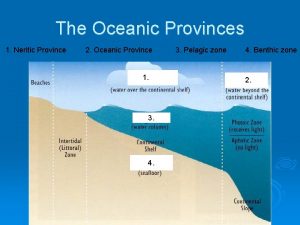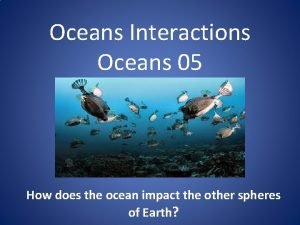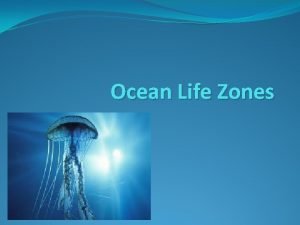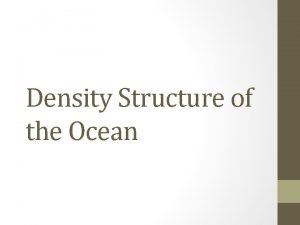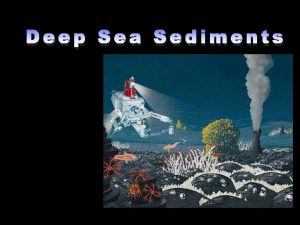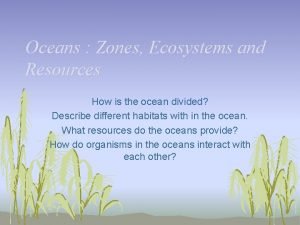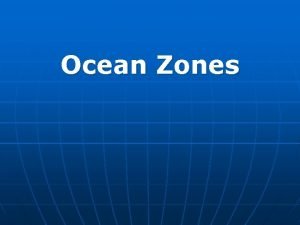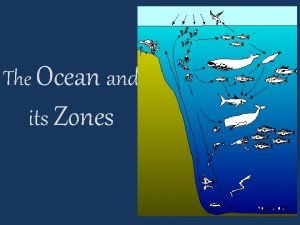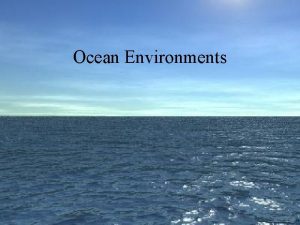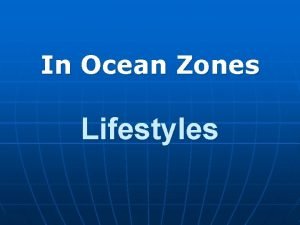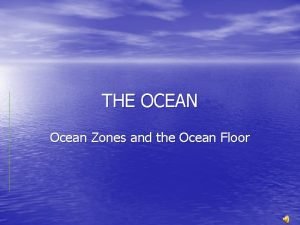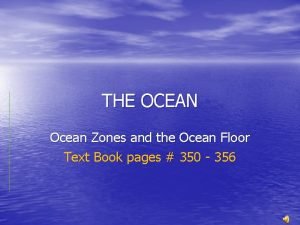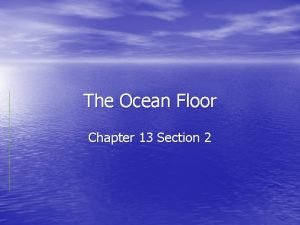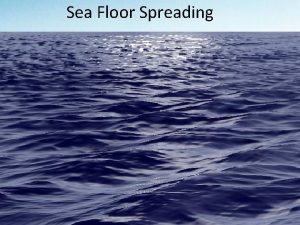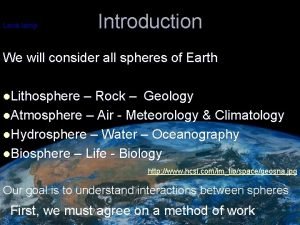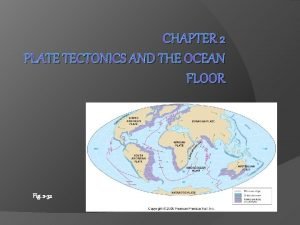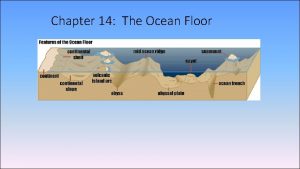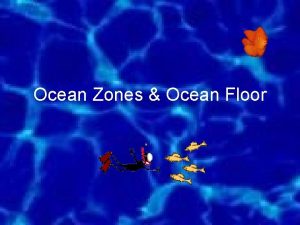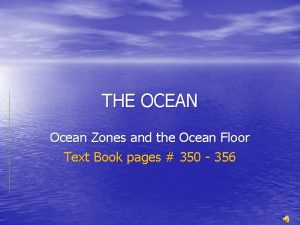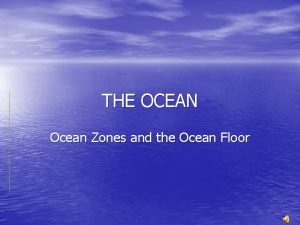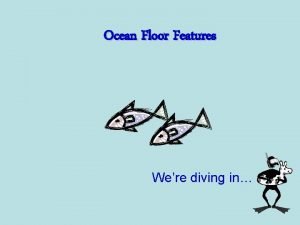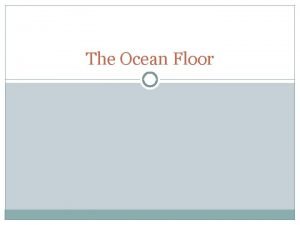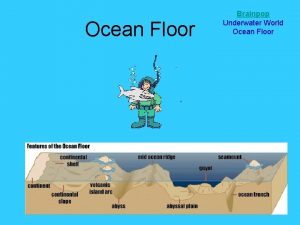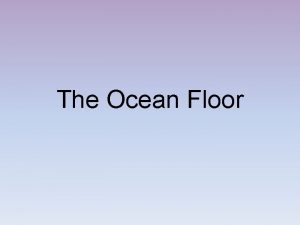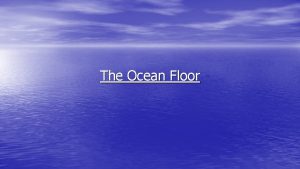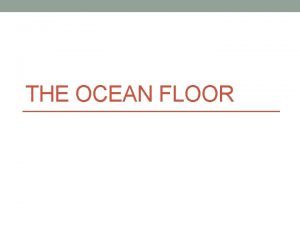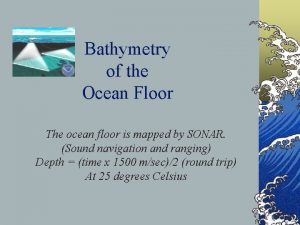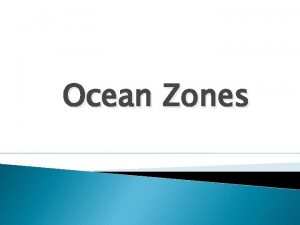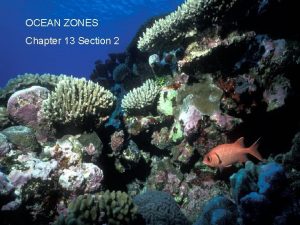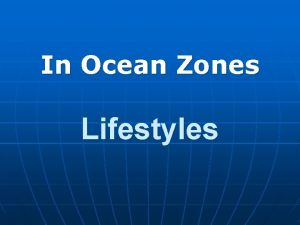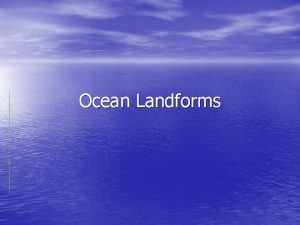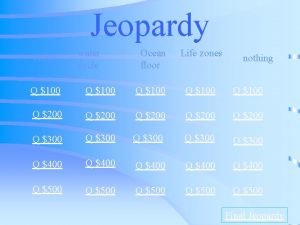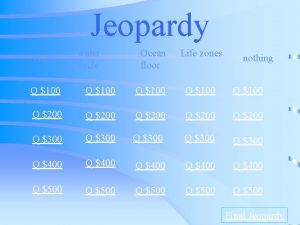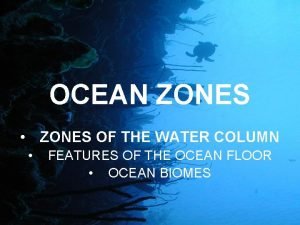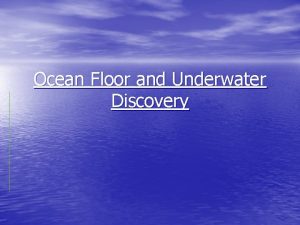THE OCEAN Ocean Zones and the Ocean Floor
























- Slides: 24

THE OCEAN Ocean Zones and the Ocean Floor Text Book pages # 350 - 356

The Ocean Floor For many years, nobody knew what was at the bottom of the ocean’s floor. Because of the darkness, cold, and extreme pressure, scientists have had to develop new technology to enable them to study the deep ocean floor.

Scientists discovered the best way of mapping the ocean’s floor was to use Sonar (Sound Navigation and Ranging) Sonar – A device that determines the distance of an object under water by recording echoes of sound waves. It creates a picture of the ocean’s floor using the recorded sound waves.

The Ocean Floor Scientist now know that the ocean’s floor is not flat.

Ocean Zones Divided into 3 zones 1. Intertidal zone 2. Neritic zone 3. Open Ocean zone

Intertidal zone – An area that stretches from the highest high-tide line on land out to the point on the continental shelf exposed by the lowest low-tide.

Intertidal Zone Intertidal zones can look like sandy beaches. Or rocky shores

Intertidal Zone Organisms that live in the rocky intertidal zone must be able to tolerate the pounding waves and changes in salinity (saltiness) and temperature.

The Intertidal Zone is over the beginning of the Continental Shelf - A gently sloping, shallow area of the ocean floor that extends outward from the edge of a continent. Continental Shelf

Continental Shelf extends in to the Neritic Zone. The Continental Shelf is also called the Neritic Zone. The Neritic Zone is full of life!

Neritic Zone of the ocean that extends from the low-tide line out to the edge of the continental shelf. The shallow water over the continental shelf receives sunlight and a steady supply of nutrients washed from the land into the ocean.

The Continental Shelf is home to the coral reef. Many animals live around coral reefs and this is a popular place for people to scuba dive.

The Continental Slope This is where the Neritic Zone ends. The dropoff or slope at the end of a continental shelf. Neritic zone

The Open ocean zone The Open Ocean zone starts at Abyssal plain. The Open Ocean is divided into two levels: A. The Surface Zone B. The Deep Zone

The Abyssal Plain - The smooth, nearly flat region of the deep ocean zone. Abyssal Plain

Abyssal Plain: The Surface Zone The only part of the ocean that receives enough sunlight to support the growth of algae.

Open Ocean - The Deep Zone The deep regions of the ocean where sunlight cannot reach. Often compared to a desert due to its harsh conditions. Few organisms live in this cold, dark, wet place.

Open Ocean – Mid Ocean Ridge Longest mountain range in the world in the middle of ocean floor Mid-ocean ridges of the world are connected and form a single global mid-oceanic ridge system that is part of every ocean.


Deep Zone Life

Deep Zone Life Organisms often create their own light. This is known as bioluminescence

Remember! Intertidal Neritic l Sl nta tine Con Shore(high to low tide) Continental Shelf Open Ocean ope Abyssal Plain

Which ocean feature (A. continental shelf, B. Continental slope, C. Abyssal Plain, and D. Trench) will have the highest of these, as we go deeper into the ocean floor? • 1. Pressure - ____ • 2. Temperature - _______ • 3. density - _____ • 4. salinity - ______

Videos • http: //video. nationalgeographic. com/video /news/us-ocean-floor-mappingvin? source=relatedvideo http: //www. schooltube. com/video/945 c 3 a 7 d 2010 a 9 c 05 ff 4/GMA%20%20 The%20 Great%20 Pacific%20 Garbage %20 Patch
 Temperate climate zone for kids
Temperate climate zone for kids How do littoral zones differ from riparian zones?
How do littoral zones differ from riparian zones? Mesopelagic zone
Mesopelagic zone Ocean and lake zones
Ocean and lake zones Hachetfish
Hachetfish Ocean zones graphic organizer
Ocean zones graphic organizer Life zones of the ocean
Life zones of the ocean Ocean zones graphic organizer
Ocean zones graphic organizer Ocean density zones
Ocean density zones 4 zones of the ocean
4 zones of the ocean 3 ocean zones
3 ocean zones Jeopardy zones of regulation
Jeopardy zones of regulation Horizontal zones of the ocean
Horizontal zones of the ocean Ocean light zones
Ocean light zones Buckshot barnacle
Buckshot barnacle Benthic zone
Benthic zone Youtube youtube youtube
Youtube youtube youtube Slidetodoc.com
Slidetodoc.com A smooth, nearly flat region of the deep ocean floor
A smooth, nearly flat region of the deep ocean floor Deep valley on the ocean floor
Deep valley on the ocean floor The process by which the ocean floor sinks beneath
The process by which the ocean floor sinks beneath Diagram of seafloor spreading
Diagram of seafloor spreading Sebastiano lava
Sebastiano lava From now
From now Chapter 14 the ocean floor worksheet answers
Chapter 14 the ocean floor worksheet answers


